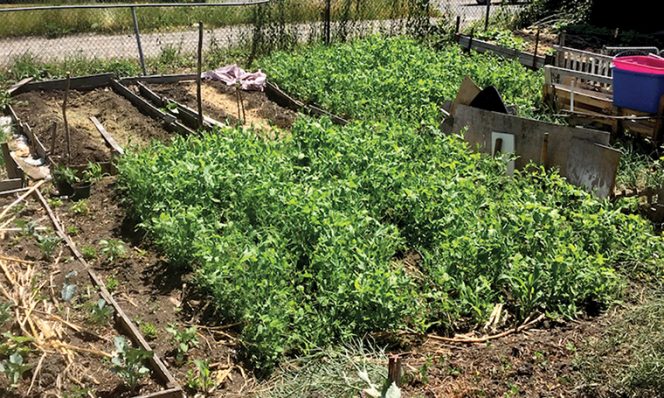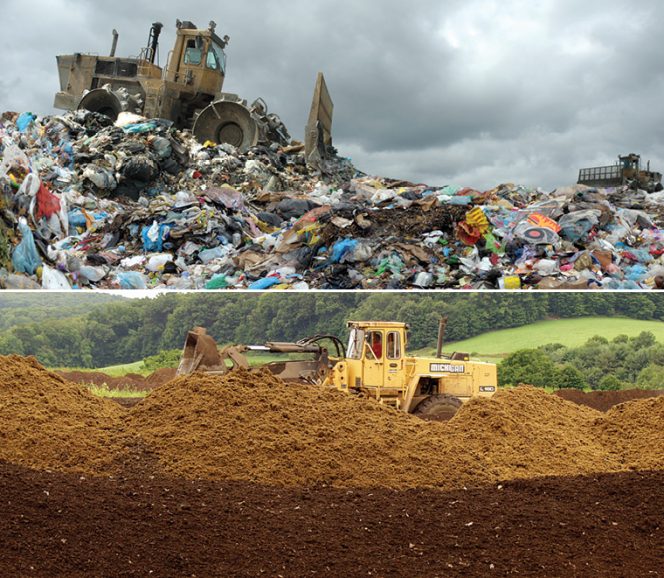
Sally Brown
BioCycle July 2019
I keep coming back to “how much is that doggie in the window in trying to find the best way to talk about ecosystem accounting. It may not be the best metaphor but it sure is sticking in my head. We have gone through a few iterations of how to best understand the costs and benefits of recycling organic residuals. To date, none of them have fully captured the benefits of the practice with a better handle on costs. Currently a new term is being used that offers the potential to get it right: circular economy. A circular economy deliberately considers the inherent value of wastes in developing products. Appropriate use of those wastes is an integral component of the process.
(Morris et al., 2017), Study also measured energy impact (MJ/kg food scraps) with landfill = 0.4 and compost = 1.14 (based on carbon intensity (CI) of energy in Oregon)
Let’s get back to the dog. In the old days the cost of the dog was how much you had to pay the pet store to take the dog home. If the price was right, you ended up with a puppy. The equivalent of the pet store transaction to residuals was the landfill tip fee in comparison to the composting tip fee. For the yard trimmings, if the composting tip fee was cheaper than the landfill, that is where the branches went. Both of these are measured in simple dollars and cents (see Standard Accounting box).
But as anybody who has a dog can tell you, the price that you pay to buy the dog is only a fraction of the actual costs of the dog owning experience. These include trips to the vet, equipment to clean the floors and the carpet and potentially an expanded budget for shoes (to replace those chewed up ones). For issues outside of canine ownership the next big advancement was life cycle assessment (LCA). Life cycle assessment considers the environmental impact of a particular practice. Impact here is almost exclusively seen as negative. Factors such as particulate emissions, emissions of sulfates, volatile organics, energy use, and carbon impact are quantified (see Life Cycle Analysis box).
By using LCAs, you can look at comparative energy use of anaerobic digestion versus landfill versus composting. You can compare the emissions associated with each practice and also look at the climate impact. On paper that sounds great — a big step from traditional dollars and cents. In reality, it has been a big step forward. But it is far from a complete analysis or accounting. Let’s go back to Spot. Using LCA you can calculate all of the pain in the neck parts of owning a dog. However, there is no provision for measuring the joy.
Measuring The Joy
For that, an additional component was added to traditional accounting and LCA — the social factor. Triple bottom line accounting considers the cost of the dog, the negative impacts of the dog and also includes how you feel about the dog. Using triple bottom line (TBL) for residuals includes the consideration of how people feel about composting versus landfilling versus anaerobic digestion. Concept here is great but trying to turn that into a quantitative evaluation is not so easy.
Back to the dog in the window. If that dog is a chihuahua and you are asking me, good chance I’d go for the cat. On the other hand, if that dog is hairy and weighs over 80 pounds I’d give a very different answer. TBL is an easily manipulated form of analysis as social factors vary based on the individual. If the person doing the analysis assumes that compost smells and landfills don’t, the conclusion of the TBL is skewed by that assumption. Both starting assumptions and the level of understanding of the individual can impact the results of the analysis. For example if you’re asked if you prefer a Basenji or a Whippet and you have no idea that both are dogs, you might end up choosing the tabby instead.
Ecosystem Services
Life cycle assessment is still commonly used. But there are indications that new and superior accounting systems are on the horizon. This change started with a paper that put a dollar value on the range of services that we get from nature (Costanza et al., 1997). Unlike LCA or TBL the focus here was the good stuff rather than any potential negative environmental impact. Ecosystem services related to compost include soil formation, waste treatment, gas regulation, water storage and treatment, and increased plant growth to name a few. By including benefits associated with a particular practice a more balanced and realistic perspective is possible.

With compost, both primary and secondary benefits are associated with its use. Monetizing the value of these services that compost provides gives you a more complete perspective and understanding than just calculating the negatives. You see increasing examples of this in the literature and in real life. The New York City reservoir system is a great example (also an excellent place to walk your dog).
New York has relied on an extensive system of reservoirs in what had been undeveloped areas north of the City for its water supply starting in the 1830s. Increasing development in combination with more intensive agriculture threatened the quality of the water. Beginning in the 1990s, New York City had two options: invest in maintaining the pristine nature of the watershed or build a large- scale plant to filter the degraded water. Both options were expected to deliver the same thing — clean water. One relied on ecosystem services while the other relied on conventional engineering. The engineering option was also several billion dollars more expensive than the natural system.
City officials chose the ecosystem services model. They spent money on improving centralized and on-site septic systems in the proximity of the reservoirs. They bought up land to limit development and they worked with farmers to encourage adoption of environmentally friendly farming practices limiting phosphorus runoff into the watershed. In other words, the City recognized the economic value of the ecosystem services associated with maintaining its clean water supply. Rather than invest in engineered infrastructure, money was spent to shore up the ecosystem services associated with its reservoirs. In hindsight this was a cost-effective and environmentally sound decision. Much of the literature on this choice and its outcomes is over a decade old. I was near part of the reservoir system last week with a friend walking her Vizsla (aka her dog) and can personally attest to many of the benefits associated with this system.
And Now … Circular Economy
Fast forward a few decades and we are now seeing the term “circular economy” appearing in the literature. The concept of a circular economy relies on explicitly recognizing and using the values of all parts of the system in product/service design and development. Translated into the language that we speak, this means that the value of the waste material is considered as part of the value chain of the product itself.
The system is designed accordingly. Waste is not an afterthought. The residual material is part of the product and its value is captured. My current favorite paper talks about how close human waste in different cities around the world is to the cropland that can use it to grow food (Trimmer and Guest, 2018). In other words, how do we design urban centers and surrounding agricultural lands to complement both? The authors suggest that the crops grown near cities be targeted to take advantage of all the protein that the human waste contains. This is taking the urban rural partnership one step further than the New York City reservoir example. In its truest form, circular economy involves deliberately designing use of the residual in the design of the product — the two are part of the same process. This is a big step from residuals as an afterthought and is a great step. It is not a final step.
A true consideration of organics goes way beyond landfill diversion and factors in both primary benefits (to soils, waters and crops) as well as secondary benefits in its evaluation. By secondary benefits, I mean the benefits to the people that are impacted by making or using the compost. For example, a neighborhood composting program would provide a range of benefits to those involved, including increased physical activity, scientific awareness, increased sense of community and the list goes on.
Think of walks in the woods with your dog, the tail wagging when you come home, and cuddling on the couch. These are the reasons you get a dog in the first place. Secondary benefits also exist with dog ownership. (See Human Impact box.) Walking that dog is good for the person who owns it (Cutt et al., 2007; Reynolds, 2019). A true accounting of the costs and benefits of dog ownership should include the emotional and health benefits for the human. In limited cases, we are seeing a comparable analysis with compost.
Hitting Pay Dirt
One example that accounts for the broad range of benefits is compost use for green storm water infrastructure. The Nature Conservancy has a number of publications on this topic. In cities where green infrastructure is combined with grey, you see a benefit in strict dollar accounting. The green costs less than the grey to install and to maintain. From a LCA perspective, it also results in lower energy use and reduced carbon dioxide emissions, so another plus there.
From an ecosystem services perspective you really hit the pay dirt. Green infrastructure uses natural processes to capture and treat storm water. The plants improve air quality and reduce urban heat island effect. From the circular economy perspective, the compost used in the bioretention systems can be made from food/yard residuals from the city itself. Finally, you get the secondary benefits not yet included in any accounting system that we have available. Green storm water systems improve the property values of the homes around them. They provide green space and recreational space for the residents of the cities with all of the associated benefits (What Is Green Stormwater Infrastructure?, The Nature Conservancy)
.
Appropriate accounting goes beyond the traditional dollar value, past a consideration of the environmental costs of a practice, all the way to fully realizing the potential benefits of a practice. For organic residuals, that includes not only any methane avoidance but all of the benefits associated with end use. It also means attempting to understand how to maximize the benefits. In my experiences with green cities — including storm water infrastructure, tree plantings and urban agriculture — the best use of these materials may be right in our back yards. If we get this right, we deserve all the treats we want and a good belly rub — things that all good dogs really appreciate.
Sally Brown is a Research Professor in the College of the Environment at the University of Washington. She authors the Connections Column in BioCycle, and is a member of BioCycle’s Editorial Advisory Board.














